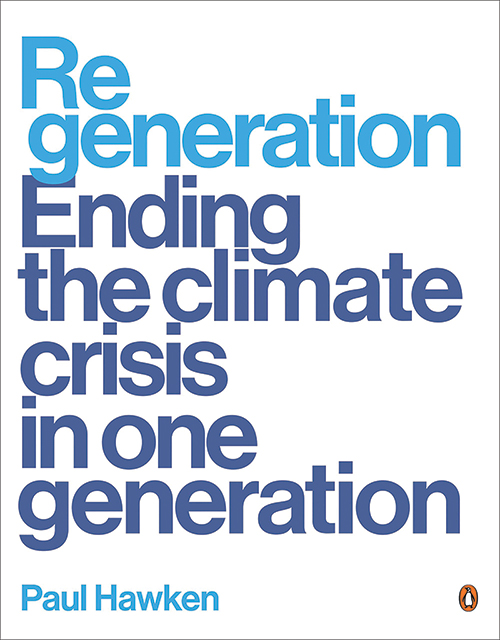
Regeneration: Ending the Climate Crisis in One Generation
Reviewed by Ruah Swennerfelt
March 1, 2022
By Paul Hawken. Penguin Books, 2021. 256 pages. $25/paperback; $15.99/eBook.
Degeneration of land, water, forests, biodiversity, and human health is a cause of climate change. And climate change is yet another cause of poverty. Turning this vicious circle to a virtuous one is crucial to addressing the climate crisis. —Paul Hawken
In 1998 my husband and I attended a sustainable economy conference in Havana, Cuba, where we represented Quaker Earthcare Witness; there we met Paul Hawken, one of the main speakers. We’ve been inspired by Hawken’s writings and commitment to a sustainable world for many years, and I’m delighted to share about his book.
Instead of focusing only on energy issues, Regeneration offers an approach to climate change that weaves together equity, justice, climate, and biodiversity. The book was written with six basic frameworks for action, and the first is equity! Hawken writes, “This comes first because it encompasses everything. All that needs to be done must be infused by equity.” It might be helpful for us to think of this in everyday terms as basic fairness; it is certainly evident in our Quaker testimonies.
Hawken reveals not just the problems but the amazing people and organizations who are addressing the problems. The topics illuminated by the book include oceans, forests, wilding, land, people, food, energy, industry, and more. There is something for everyone. If you live in the city, it’s for you with a section about what it takes to create regenerative cities. If you live near a forest, it’s for you with information about healthy forests. If you are a farmer or homesteader, it’s for you with many examples of regenerative agriculture from around the world. If you want hope, it’s there. If you want to understand how all of life is interconnected, it’s there.
I learned so much reading the book. For example, seaforestation was new to me. I knew that the ocean plants were distressed, but I didn’t know about all the efforts being made to manage and restore the kelp. According to Hawken, “The seas can turn carbon into forests at a rate exceeding that of the lushest parts of the Amazon.” Even the seventeenth-century farmers in Tokyo Bay used bamboo stakes to give young seaweed something to attach to, and then moved the plants to nutrient-rich water, which helped them to survive.
There are many examples of Indigenous people’s care of the places where they live. Many practiced what we now call “regenerative agriculture.” A friend, Galen Meyers, gives this definition of regeneration: A regenerative society maintains its life support systems in such a way that its actions of drawing from the environment actually serve to create more production, more health, more resilience, and more longevity in its ecosystems than would have been created without the participation of that society.
There is a section on “wilding” in the book. One part of that section is about trophic cascades: how the loss of one species (called a keystone species) can have a traumatic effect on all the other species in that biosystem. We learn that, “each ecosystem is a repository of carbon stored above and below ground, systems of life that are unimagined in their full complexity.” We learn there are three types of keystone species: there are predators that control the population (think eagles), engineers that physically transform their environment (think beavers), and there are mutualists who recognize that their survival depends on the well-being of other forms of life (think red-billed oxpecker). Hawken asks which one of these types of keystone species humanity should choose to be.
Woven into the fabric of the book is a foreword by Jane Goodall, as well as many essays by authors, farmers, and Earth activists. This adds to the richness of the book; it is literary, scientific, inspiring, and informative.
I want to end this review with a quote from a section on the War industry, since this is an issue near and dear to Friends. Hawken suggests that we change the purpose of militaries to play a key role in securing our future, because, he says, the climate crisis threatens and undermines the security of everything. He goes on to write:
“Scientists Recommend These 4 Weapons in Our War Against Climate Change” reads one headline. If we understood what we face, we would not find war a useful metaphor to describe the solution. Global warming is a massive force beyond human comprehension, but it is not the enemy.
Ruah Swennerfelt is a member of Middlebury (Vt.) Meeting, where she serves on the Earthcare Committee. Before retiring, she served as general secretary of Quaker Earthcare Witness. She and her husband are homesteaders, using regenerative practices, and receive all their electric energy from the sun.


